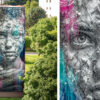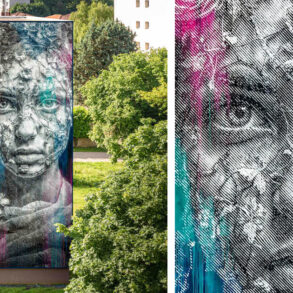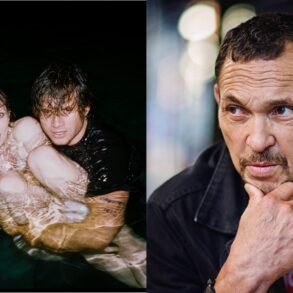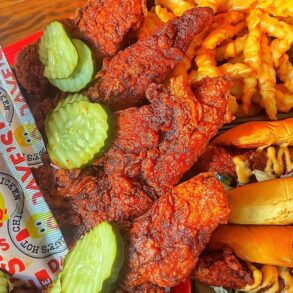Photographing sticker art started as a hobby for Roni Hind, but when she’d accumulated more than 5,000 shots, she had to acknowledge that stickers had become her passion.
And it was time to do something with it.
Inspired by sticker expos she’d heard about around the world, she founded the Sydney Sticker Expo, which she believes to be the first of its kind in Australia.
Hind, who curated and organised the expo of sticker art from Australia and across the world, is drawn to the democratic nature of sticker art.
“I really enjoy the accessibility of it,” she says.
A sticker placed somewhere is a sort of invitation for more, and overlapping, stickers to be added.
Sticker art, a sub-culture of street art, isn’t always cheap to create, but Hind says there are ways to do it on a budget.
“Not everybody is able to go to art school, but they can still express their art through a sticker.”
From political messages and cheeky parodies of well-known logos, to cute animals and graffiti-style tags, there’s a lot of ground being covered by Australia’s sticker artists.
More than 150 artists from 13 countries submitted stickers to the expo.
A subculture of street art, sticker art is democratic, accessible and born from a strong community of creators. (Supplied: Roni Hind)
Hind says the scene in Australia is thriving, though relatively small compared to countries like the United States and Germany.
Inspired by Banksy
One of the featured artists in the expo is Melbourne’s Robbo-T, who has been creating stickers for about five years. His work often features an expressive silver robot exploring its environment.
Loading Instagram content
Robbo-T became interested in making stickers on a street art tour in Sydney, where he noticed a sticker from a well-known local artist.
“That was an ‘a-ha’ moment that opened my eyes to the whole sticker culture,” he says.
He’s inspired by Banksy’s playful approach, and particularly the way the renowned street artist “is able to interact with the world around him; his pieces interact with drain pipes and shop fronts”.
“There are a lot of big, plain, industrial-looking areas out there, and stickers are a way of bringing some of those to life and adding a little bit of interest to people’s daily commutes,” Robbo-T says.
Like many sticker artists, he enthusiastically trades his work with other artists.
“You make connections locally and internationally,” he explains.
“It’s a unique sticker thing. People will send you their stickers that you’ll put up in your region.” (He was recently chuffed to hear one of his stickers was spotted in Türkiye.)
Robbo-T joined a group that meets monthly in Melbourne to do street art in laneways and he says he was “dubious” when the group first invited him.
“I’m a bit older, and I was expecting [the group members] to be the stereotypical kind of taggers,” he says.
“But what I found was a group of artists of all different types and age groups. There was a mixture of photographers, people that did stencils, paste-ups [posters or paper art that is pasted on walls] and old-school graffiti artists who have been spraying their whole lives.
“It’s a vibrant community.”
Artists living double lives
Sydney’s Onnie O’Leary, also a prominent tattoo artist, branched out into stickers around 2021.
Her work — both tattoos and stickers — is inspired by erotic comic books of the 1970s, and often depicts vividly coloured angels and demons.
O’Leary branched out into stickers around 2021, initially giving her stickers to her tattoo clients as a promotional tool. (Supplied: Onnie O’Leary)
She says, like street art, sticker art appeals to creatives who want to keep their identity a secret.
She’s had in-depth online conversations with other sticker makers without knowing their names.
“We’re just going off handles. I don’t know what gender they are or how old they are, but regardless of those things, we have these stickers in common and that becomes the generative spark for swapping and talking about art.”
Hind enjoys the anonymity of the scene.
“That’s kind of the excitement of it … everyone’s almost got this double life. A lot of my friends don’t even know that I take photos of street art.”
‘Undercurrent of art and activity’
Sticker artists often paste their works in public spaces in a practice known as sticker slapping or sticker bombing. Certain areas can organically become home to a cluster of stickers.
“It tends to be contagious,” O’Leary says.
“One person sees a sticker, then they put another one down, and then someone else comes along and adds to that, until there are layers and layers of overlapping history there.”
O’Leary found promoting her art work on social media was getting harder and harder. “So I thought, ‘What about the real world?'” (Supplied: Onnie O’Leary)
While she loves coming across stickers in the wild, O’Leary’s looking forward to seeing this often guerilla art form in the expo’s gallery space.
“Often, I think [sticker art] is looked at as graffiti — with a negative rather than artistic connotation.”
But they’re “really beautiful”, she argues.
“I love that there’s this undercurrent of art and activity that’s happening just on the surface of the streets that a lot of people don’t notice.”
The Sydney Sticker Expo is at Goodspace Gallery on April 23.
This post was originally published on this site be sure to check out more of their content.








